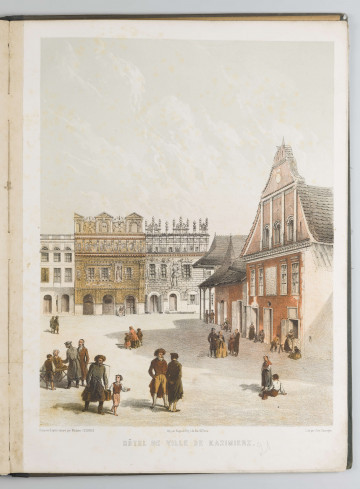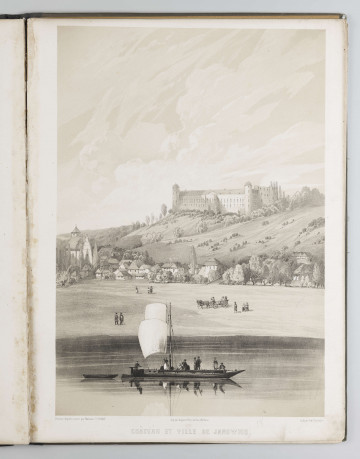
Hotel de ville de Kazimierz
1860
National Museum in Lublin
Part of the collection: Lubliniana. Painting views of Lublin and the Lublin Region
The colourful graphic composition depicts an architectural landscape in Puławy. The card comes from the lithographic publication Album des vues de l'Institut Alexandra du jardin et des environs de Novo Alexandra (Puławy), published in Paris in 1858. The book contains twenty-four lithographs made by A. T. Cassagne. The author of the drawings and watercolour prototypes was a talented draughtswoman, Barbara of Groten Czernof. In the 1850s, she worked as a supervisor and drawing teacher at the Alexandria Institute for the Education of Ladies in Pulawy. The institute was located in the Czartoryski estate confiscated by the Russians after 1831. The artist made many works showing the corners of the former residence and views of the surrounding areas.
The theme of this romantic representation is Villa Samotnia surrounded by picturesque greenery, among which few strollers can be seen. The history of this original residential building is connected to Łucja Rautenstrachowa, a descendant of the old Lithuanian ducal family of Giedroyc, wife of General Józef Rautenstrach.
Łucja was an extraordinary woman - a writer (author of sentimental novels), translator, collector and keen traveller. During a grand tour of Europe, she met Polish emigrant poets: Julian Ursyn Niemcewicz, Adam Mickiewicz, Cyprian Kamil Norwid, and established close contacts with the Czartoryski family. She left several volumes of excellent travel descriptions. In 1853, she left the big world and settled in Puławy, which enchanted her with its beautiful location and nature as well as abundance of historical monuments. The villa she built according to her design resembled the Romantic Gothic style. The octagonal tower was for some time the seat of a Masonic lodge. In the house, filled with souvenirs and works of art, the general led a cultural salon for the intellectual elite of Puławy. A few years later Lucja, after giving Samotnia back to her family, moved to Villa Cienista. She opened its doors to guests, especially student youth. Łucja Rautenstrach died in Puławy in 1886 at the age of eighty-eight.
In the interwar period a vinegar factory operated at Samotnia. After the war it was turned into a council flat, as the result of which it fell into disrepair. Since the 1990s it has been looked after by the Society of Friends of Puławy.
Author / creator
Dimensions
cały obiekt: height: 39,6 cm, width: 29 cm
Object type
graphics
Technique
lithography
Material
cardboard
Creation time / dating
Creation / finding place
Owner
The National Museum in Lublin
Identification number
Location / status

1860
National Museum in Lublin

1860
National Museum in Lublin

1860
National Museum in Lublin
DISCOVER this TOPIC
National Museum in Szczecin
DISCOVER this PATH
Educational path